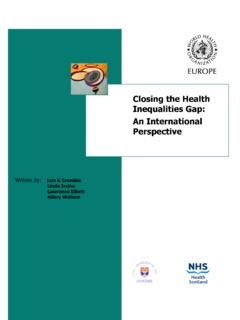Transcription of ROAD SAFETY IN THE WHO AFRICAN REGION THE …
1 1 ROAD SAFETY IN THE WHO AFRICAN REGION THE FACTS 2013 At a glance The AFRICAN REGION has the highest road fatality rates of all the world s regions Young men are the most vulnerable road users Pedestrians, cyclists, and persons travelling on motorized 2- and 3-wheelers are at great risk of death and injury on the roads Most countries still lack policies for protecting vulnerable road users and promoting investment in public transportation Most countries are yet to enact comprehensive laws concerning the major risk factors of speed control, drink-driving, helmet use, seat-belt use, and child restraint. Even where comprehensive laws are in place, poor law enforcement renders the laws ineffective Post-crash care is inadequate or lacking in many countries Made possible through funding from Bloomberg Philanthropies 2 Background In 2010, concerned about the very high and increasing burden of road traffic crashes around the world, the United Nations General Assembly adopted Resolution 64/2551, which proclaimed 2011 2020 the Decade of Action for Road SAFETY .
2 The goal of the Decade is to reduce the increasing trend in road traffic deaths, and to save an estimated 5 million lives over the period. The Resolution followed the publication of the first Global status report on road safety2, which had showed, among other major findings, that the AFRICAN REGION had one of the highest rates of road traffic deaths, along with the Eastern Mediterranean REGION . In order to guide national responses to achieve the decade goal, a global Plan of Action3 was developed. It provides a practical tool to support governments and other national stakeholders in the development of national and local plans of action, as well as a framework for coordination of activities at regional and global levels. It was determined that the improvement of road SAFETY would be hinged on improvement in the following five areas, also termed pillars for the decade: road SAFETY management, safer roads and mobility, safer vehicles, safer road users, and post-crash response.
3 UN General Assembly Resolution 64/255 also called for regular monitoring of the global progress towards meeting the targets identified in the Plan of Action. The data collection , for each country was based on a standard questionnaire which was filled by a multi-sectoral group of respondents and validated in a consensus meeting. The data were cleaned and analysed and modeling was used to adjust all reported deaths to the standard thirty day definition. This AFRO factsheet is developed with data from the second Global status report on road SAFETY 2013: supporting a decade of action which serves as the baseline to monitor the Decade of Action for Road SAFETY . Of the 46 countries that make up the AFRICAN REGION , 44 countries participated4.
4 Except where otherwise stated, the data and analyses presented are based on the responses of those 44 countries , home to of the regional population. Data are provided on the burden of road crashes (deaths, injuries, economic cost) and the state of implementation of interventions related to the above pillars. _____ 1 2 3 4 Algeria and Eritrea did not participate. 3 I - Deaths on Africa s roads The AFRICAN REGION remains the least motorized of the six world regions , but suffers the highest rates of road traffic fatalities (Figure 1), with 37 of 44 surveyed countries having death rates well above the global average of deaths per 100 000 population (Figure 2). While the regional average is deaths per 100 000 population, for the 19 countries in the middle-income category, covering 44% of the REGION s population, the rate is deaths per 100 000 population.
5 By comparison, the global average for middle-income countries is deaths per 100 000 population. Figure 1: A comparison of regional populations, road deaths, and registered vehicles While the AFRICAN REGION possesses only 2% of the world s vehicles it contributes 16% to the global deaths. Nigeria and South Africa have the highest fatality rates ( and deaths per 100 000 population per year, respectively) in the REGION . More than one in four deaths in the AFRICAN REGION occur on Nigeria s roads, and with six other countries ; Democratic Republic of Congo (DRC), Ethiopia, Kenya, South Africa, Tanzania, and Uganda, are responsible for 64% of all road deaths in the REGION (Figure 2). While Ethiopia, Kenya, and Tanzania have relatively low (for the REGION ) road fatality rates, Nigeria, South Africa, and Uganda combine big populations with very high fatality rates, resulting in large numbers of deaths.
6 These seven countries must reduce their road deaths considerably if the REGION is to realize a significant reduction in deaths. While statistics clearly point to a high economic cost to the respective countries , only nine countries provided an estimate of the cost in terms of the Gross Domestic Product. This ranged from 1% in six of the countries , to 9% in Angola. AFRO = AFRICAN REGION , AMRO = American REGION , EMRO = Eastern Mediterranean REGION , EURO = European REGION , SEARO = South East Asian REGION , WPRO = Western Pacific REGION 4 Figure 2: Road death rates 2010 CAR = Central AFRICAN Republic DRC = Democratic Republic of Congo STP = Sao Tome & Principe. 5 II - Fatality data Definitions and data sources vary widely. Only 16 countries (37%) use the internationally recommended definition of a road death, as that occurring within 30 days of the crash (Figure 3).
7 In 77% of the countries fatality data come exclusively from police records. A further 16% use a combination of police and health facility records. Figure 3: Distribution of countries according to definition of a road death The majority of persons killed on the roads are young adults, with 62% of all deaths aged between 15 and 44 years (Figure 4). In twenty countries ( regional population) where data on sex were available, three out of every four deaths were male. Young men were the most vulnerable of road users in the REGION . Figure 4: Road traffic deaths by age group (12 countries ) Vulnerable road users pedestrians, cyclists and motorized 2- and 3-wheelers constitute more than half (52%) of road users killed on the roads, with pedestrians alone being 37%.
8 There are significant variations across countries . For instance Mozambique and Liberia have and of road deaths respectively being pedestrians, compared to DRC with only 5% pedestrians. _____ 5 Botswana, Comoros, Central AFRICAN Republic, Ethiopia, Ghana, Lesotho, Mauritius, Mozambique, Namibia, Seychelles, South Africa, and Swaziland. 6 Figure 5: Road traffic deaths by type of road user III - Vehicles and mobility Except for legislation requiring that new cars being imported into the country be fitted with seat-belts, only a small minority of countries have laws regarding anti-locking brake system (six countries ), electronic stability control (three countries ), or airbags (four countries ). Given the weak policing in the majority of the countries , it means that once the opportunity to check the quality of vehicles is missed at the point of importation, it is much more difficult to ensure a quality fleet on the roads.
9 Motorized two- and three-wheelers form substantial proportions of the fleets in many countries (Figure 6). Figure 6: Vehicle mix in 17 countries Only two countries have national policies that encourage walking and/or cycling as an alternative to car travel, while one in four (11) countries have national policies to support investment in public transport as an alternative to car travel. Whereas the majority of people in these countries already rely on walking and cycling anyway, it does mean that low investment in these modes makes them very risky, and explains the high rates of deaths and injuries in precisely these types of road users. As the populations in these countries continue to grow, the pressure for mobility, especially in the urban areas, will result in more people being driven into these high risk modes of transportation.
10 7 Only 12 of 44 countries have national policies to separate road users. Buses make up a very small proportion of the fleets. In most urban centers those commuters who cannot afford personal cars have tough choices: mini-buses or commuter vans, two- or three-wheelers, or walking. Mini-buses tend to be out of financial reach of low income earners, and in most countries they have poor SAFETY records. ROAD SAFETY MANAGEMENT & POLICIES Road SAFETY management parameter Number of countries countries countries with funded national strategy that sets targets for reduction of deaths & injuries 12 Burkina Faso, Central AFRICAN Republic, C te d'Ivoire, Equatorial Guinea, Ghana, Kenya, Lesotho, Mauritania Mauritius, Namibia, Rwanda, Zambia countries with national policies to separate road users as a way of protecting vulnerable road users 10 Benin, Burkina Faso, Cameroon, Ethiopia, Malawi, Mali, Namibia, South Africa, Tanzania, Zimbabwe countries with national policies to support investment in public transport 11 Benin, Equatorial Guinea, Ethiopia, Ghana, Kenya, Mauritania, Niger, Nigeria, Senegal, South Africa.














